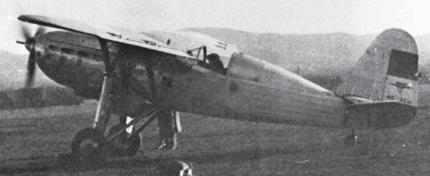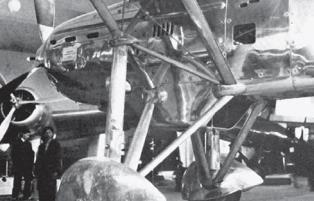The main difference from the IK-1 was that the IK-2 had wings covered with metal sheeting, leaving only the rear fuselage and tailplane fabric covered. The new wing was tested with both fabric and metal covering at the request of the VVKJ. Other changes were a radiator of reduced size and improved shape, and modified air intakes, making for a more streamlined fuselage.
After the second prototype was delivered, the aircraft was placed in the hands of a different test pilot, Poručnik (1st Lieutenant) Janko Dobnikar, who conducted its first flight on 24 August 1934. Dobnikar had worked closely with the designers and Ikarus during its construction and static testing, and his suggestions had resulted in an improved cockpit layout. He strictly followed a completely new test program, while installed testing equipment recorded the various characteristics of the aircraft. After gaining complete mastery of the aircraft, he conducted some aerobatic manoeuvres during a visit by the future Turkish president İsmet İnönü, which included a complete inverted loop. In mid-October 1935, Dobnikar broke the unofficial European air speed record for an aircraft with a fixed undercarriage, attaining a speed of 435 km/h , which was also a Yugoslav air speed record. The aircraft was able to achieve greater than expected power at altitudes of 4,000-5,000 m. Dobnikar completed the testing program and submitted his report to the VVKJ on 23 May 1937
After VVKJ acceptance, a group of pilots conducted 16 mock dogfights between the IK-2 and the Hawker Fury I biplane already in service with the VVKJ, during which the IK-2 displayed overall superiority over the British-built aircraft. At one point, Bajdak declared his continuing doubts about the aircraft, and Dobnikar challenged him to a duel, with Bajdak flying his preferred aircraft, the Fury I. After Dobnikar won the climbing competition and a race to Zemun and back from Belgrade, the final dogfight forced Bajdak to concede that the IK-2 was the better aircraft. On 20 November 1937, the VVKJ submitted a proposal to order a batch of 12 IK-2s, which was approved the following month. The production version included some additional improvements, but continued testing resulted in further delays, with the aircraft not entering service for another year. By this time, international consensus had coalesced around the superiority of the low-wing monoplane, and the IK-2 was already obsolescent by the time it was delivered to VVKJ fighter units.
The first six production aircraft were delivered to the 6th Fighter Regiment of the VVKJ, based at Zemun, in early 1939. The pilots subjected them to considerable additional testing, before they entered normal service around mid-year. The remaining six entered service during the remainder of 1939. The aircraft were delivered without radios or armament, which were fitted in VVKJ workshops. In October 1939, the IK-2s were transferred to the 4th Fighter Regiment in Zagreb until licence-built Hawker Hurricanes were delivered from Zemun, after which the IK-2s were to be transferred to the 5th Fighter Regiment in Niš. By the end of 1940, all the production IK-2s were concentrated in the 107th Fighter Squadron of the 34th Fighter Group, which consisted solely of IK-2s. This was only an interim allocation, as the other squadron of the group was equipped with Hurricanes, and as soon as the 107th Fighter Squadron could be equipped with Hurricanes, the IK-2s were to move to the 5th Fighter Regiment. The threat of war overtook this planned deployment, and on 13 March 1941, the IK-2s of the 107th Fighter Squadron were moved to Bosanski Aleksandrovac near Banja Luka,[10] under the command of Kapetan Zarko Vukajlović.
When the German-led Axis invasion of Yugoslavia commenced on 6 April 1941, only eight IK-2s were serviceable. One had been damaged in a landing accident, two were at the workshops in Zagreb being repaired, and the fourth unserviceable machine was in a badly damaged condition at Bosanski Aleksandrovac. That day and the next, the 107th Fighter Squadron patrolled over Bosnia but did not make any contact with the enemy. Two machines conducted a combat air patrol over the airfield of the 8th Bomber Regiment at Nova Topola. This pattern continued the following day without incident, but patrol duration and coverage was limited by the short range of the aircraft. On 8 April, a patrol unsuccessfully gave chase to a lone German reconnaissance aircraft, and later in the day, one of the IK-2s force landed, leaving seven operational aircraft.
About 14:00 on 9 April, two Staffeln of German Messerschmitt Bf 109 fighters from II. Gruppe of Jagdgeschwader 54 were observed heading towards Nova Topola just as two IK-2s were landing after a patrol in poor flying weather. One of the IK-2s managed to overshoot and climbed to meet them, but the other was unable to, and had to complete its landing. Podnarednik (Junior Sergeant) Branko Jovanović used the extreme manoeuvrability of his IK-2 to avoid the nine Bf 109s that swooped in to attack, while a total of eight Hurricanes and five more IK-2s from the 4th Fighter Regiment scrambled to meet the Germans. For the following seven or eight minutes, a furious dogfight ensued over Novo Topola, during which two German aircraft were claimed and two Hurricanes and one IK-2 were lost. German records indicate that only one of their aircraft was lost, and that the pilot survived. Podnarednik Stikić survived the loss of his IK-2, but was badly wounded. The Germans, low on fuel, broke off and headed north.
The following day, one IK-2 force landed due to engine failure, reducing the number of serviceable IK-2s to five. Despite deteriorating weather conditions and revolts within the Yugoslav forces, combat patrols continued. At 12:00 on 11 April, all aircraft were grounded by the weather. On 12 April, aircraft of the 4th Fighter Regiment took to the air again, chasing German reconnaissance aircraft, but the IK-2s did not record any victories. The following day, the 4th Fighter Regiment continued carrying out sorties, but around 12:00 the commander of the 2nd Mixed Air Brigade ordered the remaining aircraft of the 4th Fighter Regiment to be destroyed, and all personnel to withdraw via road to Sarajevo.The war story of IK-2 was not finished yet.
German units captured four IK-2 fighters (2103,2104,2111,2113), and one , No 2106 was found damaged but repairable on the war airfield in Bosnia. The planes were overhauled in repair workshops in Sarajevo and Zemun. IK-2s were given to the newly created Croatian Independent State air force. Serial numbered 2901,2902,2903,2904, with the fifth IK-2 serial
unknown. These planes served at 2 Zrakoplovna Luka (Air base) Rajlovac near Sarajevo in 6th Grupa 17. Jato ( 6th Group 17th Flight). During late 1942 , they were transferred to 5. Jato(5th flight) in Banja Luka, where they served until 1944. but due to a shortage of spare parts just two were operational. In 1944 all the IK-2 were withdrawn from
service and not a single sample survived the war.
Fuselage:
Chrome-Molybden steel tube structure with sheet duraluminium covering at engine and cockpit section, fabric covered aft cockpit section and tailplane. Pilot Plexiglass sliding canopy slid down into fuselage sides, like car side windows.
Wings:
Gull wing (Pulawski wing) configuration,.The shoulder high wing, all metal structure,with front and rear box spars , series production IK-2 have metal duraluminium skinning . Semi cantilever type with attachments of wing roots to upper fuselage and wing struts to lower fuselage attachment points. Ailerons were metal frame, fabric covered,located at dummy spars and have twin features, working as ailerons , but could be deployed as landing flaps,to a maximum of 15 deg.
Tailplane:
All metal frame with fabric covering , aerodynamically and mass balanced ,tailplane trim was adjustable in flight.
Landing gear:
Fixed main gear and steerable tailwheel. Main undercarriage employing Messier Oleo-Pneumatic shock absorbers and pilot operated wheel brakes.Spats were installed on prototype and first series production plane, but were later removed.
Engine:
One 860 HP (at 3100m) Hispano Suiza HS 12 YCrs, liquid cooled 12 cylinder-upright Vee inline engine. Supercharger is set at 3100m .Ratier three blade propeller was pitch adjustable type and was driven via reduction gear.
Engine cooling system was Chausson type and located under the fuselage. Fuel and oil tanks were placed in the fuselage, in front of the cockpit compartment.
Armament:
IK-2 series production planes were armed with two fuselage side mounted DARNE Mle 1930 7,7 mm machine guns with 250 rounds per gun and one Hispano HS-9 , hub firing 20 mm cannon with 60 rounds. In 1940, some IK-2s were rearmed with one 7,92 mm FN machine gun replacing HS-9 20 mm cannon, but until February 1941, almost all were rearmed to original configuration. Standard RYAF gunsight installed on IK-2 was Kretien gunsight (similar to ALDIS tube gunsight) or simple ring and bead gunsight.
| Type |
Single seat fighter |
| Engine |
1 Hispano Suiza 12Ycrs with a 3-blade adjustable pitch prop. |
| Dimensions |
Length 7,88 m , height 3,84 m , span 11,4 m , wing area 18,0 m2 , |
| Weights |
Empty 1502 kg, loaded 1857 kg , fuel 250 kg |
| Performance |
Max.. speed 435 km/h at 5000 m , cruising speed 250 km/h , range 700 km, endurance , service ceiling 12000 m , climb 5000 m 5 min. 25 sec. |
| Armament |
1 × 20 mm Hispano-Suiza HS.404 cannon with 60 rounds in a spiral drum 2 × 7.92 mm Browning/FN machine guns with 250 rounds per gun |
| Type |
Werk.Nr |
Registration |
History |
|
3 |
VeBr.2103, ZNDH 2902 |
Captured by the Germans, given to the Croatian Air Force |
|
4 |
VeBr.2104, ZNDH 2901 |
Captured by the Germans, given to the Croatian Air Force |
|
11 |
VeBr.2111, ZNDH 2903 |
Captured by the Germans, given to the Croatian Air Force |
|
13 |
VeBr.2113, ZNDH 2904 |
Captured by the Germans, given to the Croatian Air Force |
|
6 |
VeBr.2106 |
Captured by the Germans, damaged but repaired, given to the Croatian Air Force |

